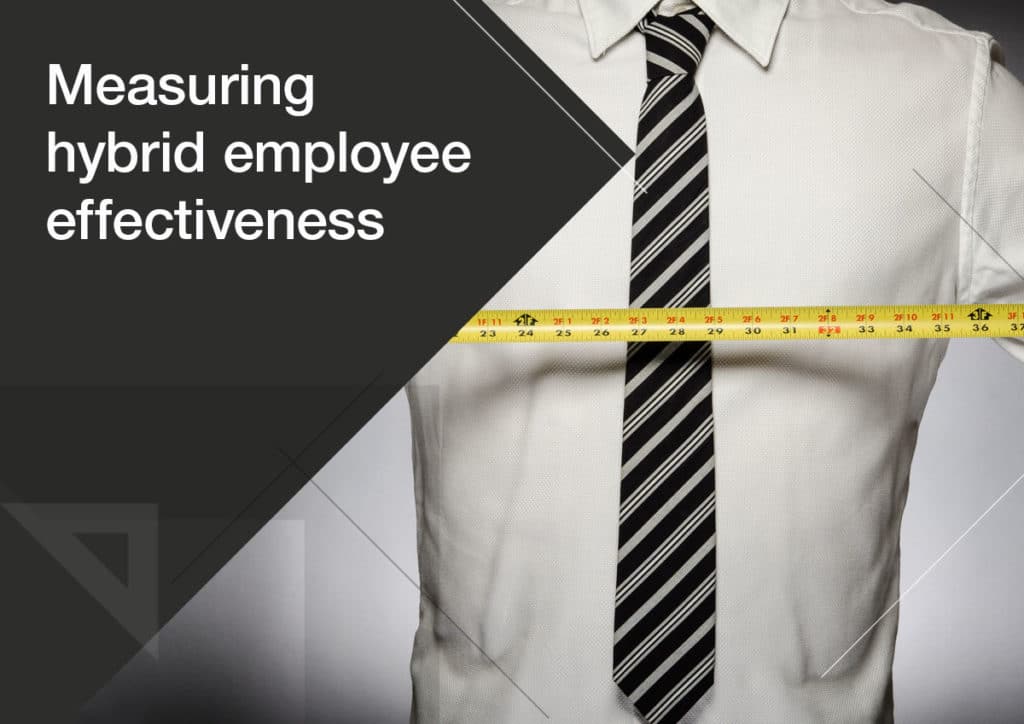Measuring Hybrid Employee Effectiveness: You Can’t Apply Old Logic to New Ways of Working
-
October 28, 2021
- Posted by: Pete Summers

In today’s data-driven world, organizations monitor and measure a multitude of variables that impact their operations. From gathering data on sales figures and trends, to customer satisfaction and feedback scores, to supply chain and logistics performance. Businesses know they need to measure such factors so they can quantify their impact on the bottom line and spot areas where they need to act and improve.
But all too often, organizations don’t apply the same level of thought to how employees are performing in the workplace and what barriers they might be facing. What’s more, as many businesses have transitioned to a hybrid workplace – enabled by the rapid adoption of digital technologies – teams have become dispersed. Against this backdrop of change, a new approach to measuring hybrid employee effectiveness is needed.
New world, new rules
An annual staff survey won’t cut it anymore. It might feel like a useful exercise, but a one-off snapshot of how teams are feeling on a single day tells business leaders nothing about how their workforce contributes to performance. Traditional metrics that focus solely on employee “output” are also limited – things like total hours worked, emails sent, or calls made, are too simplistic and lack business context. Without the context of an individual’s role, team, location, etc., such data points can’t give real insight into effectiveness.
The number of people sitting at a desk for a set number of hours is also no longer relevant. At the same time, digital “presenteeism” is just as damaging as it is in the physical realm. Counting hours spent connected to a VPN is not a true measure of efficacy. For example, an employee online until 10pm might, in isolation, look like a red flag for overworking or inefficiency. But if that employee spends their afternoons caring for children and prefers to work later in the day when there are fewer disturbances – then that employee is on the road to success.
In a hybrid environment, a more sophisticated methodology of measurement is required. Such raw numbers without context lack any kind of deep insight into how effective an employee is, or whether there are any barriers to success that are holding them back. It’s a multidimensional challenge requiring new KPIs and metrics.
Sophisticated measurement
The good news for organizations is that modern workforce analytics can apply a sophisticated layer of measurement that enables this approach. Scalable Software’s workforce analytics platform, Acumen, enables organizations to measure, optimize and transform employee experiences to improve efficiency.
Acumen allows single data points to be linked and a wide variety of metrics to be measured. It connects these data points and gives organizational context that helps users to derive meaningful insights. For example, users can identify if certain teams in certain geographies are performing particularly well and look to apply their best practices to other teams. They can also evaluate the impact of technology on how effective employees can be – like changes in workflow or process, adoption of new solutions, and how collaboration tooling is configured.
At Scalable Software, we help you identify the KPIs and metrics that are most valuable to your organization and give visibility into how your teams are performing and how you can help them develop. Here are some examples of useful KPIs for a hybrid workforce.
- Collaboration streamlining: Measuring user adoption of Microsoft Teams for communication and collaboration against the usage of other products in the estate.
- Communication efficiency: Tracking improvements in communication efficiency achieved by adopting Microsoft Teams messaging over legacy e-mail.
- Application Stability: Determine stability of end-user applications and identify any potential impact on user experience or effectiveness.
Relational analytics is also important in assessing the hybrid workforce. Understanding how teams collaborate, levels of isolation and influence, and the strength of a person’s network, all offers insight into what makes people and teams effective. Identifying these factors allows organizations to apply learnings to other teams to replicate successful performances and behaviors.
By collating and distilling data from across an organization’s infrastructure, using digital KPIs and metrics, and employing dashboards and data visualization, leaders can achieve a data-driven view of employee effectiveness that is fit for the new hybrid world. Learn more about how Acumen can help your organization.